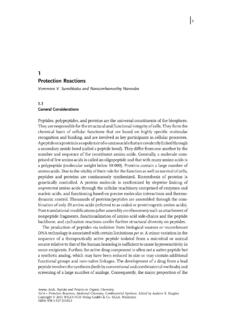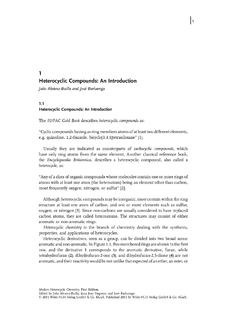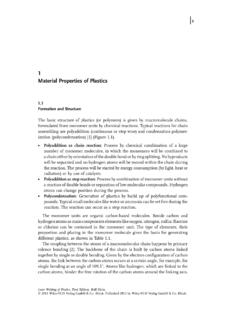Transcription of 1 Nanomaterials:ClassificationandProperties
1 11 nanomaterials : Classification and PropertiesFrancesco Trotta1and Andrea Mele21 University of Torino, Department of Chemistry, Via Pietro Giuria 7, 10125 Torino, Italy2 Politecnico di Milano, Department of Chemistry, Materials, and Chemical Engineering Giulio Natta , PiazzaLeonardo da Vinci 32, 20133 Milano, Nanomaterial ClassificationsThe word nano derives from the latin word nanus andGreekword , both indicating a person of very low height, a dwarf. The International Sys-tem (SI) of units considers nano as a prefix to indicate 10 9part of a unit; thus,for instance, a billion of a meter, a billion of a liter, a billion of a kilogram, etc. Notalways the term nano is referred to a very small object. For instance, in astron-omy, a nanostar is a star having a mass comparable to our Sun or even less. Afirst, easy, and practical criterion to define nanomaterials is based on the dimen-sions tout court : nanomaterials are conventionally defined as materials havingat least a dimension between 1 and 100 nm.
2 As a consequence, nanoparticles haveall the three dimensions in the nanometer range, nanoplates present only onedimension below 100 nm, whereas nanofibers have two dimensions in the rangeof nano being the remaining remarkably longer. Some common terminologies ofthe nanorange world are listed in Table , 100 nm as an upper limit for a nanomaterial is not alwaysaccepted. Many organizations in the world fixed different thresholds for thenanoscale, although 100 nm still remains the most common shared presents some recommendations suggested by different is immediately clear that adequate techniques to determine the dimensions ofthe nano-objects are required. Table reports the methods till now available tomeasure the size of the objects in the nanometric range. To avoid incorrect resultsand classification, particular care and attention should be devoted to (i) preparea representative sample for analysis, (ii) follow a correct sample preparation,(iii) use the most appropriate mathematical analysis to get size distribution, and(iv) consider the comparability among different laboratories.
3 Detailed guidelinesfor sample preparation in GMO analysis were reported in the Joint ResearchCentre (JRC) technical report in 2014 [3].A sketch of nano-objects is reported in Figure : Synthesis and Applications,First by Francesco Trotta and Andrea Mele. 2019 Wiley-VCH Verlag GmbH & Co. KGaA. Published 2019 by Wiley-VCH Verlag GmbH & Co. nanomaterials : Classification and PropertiesTable definitions of terms with the nano range from approximately 1 100 nmNano-objectMaterial with one, two, or three external dimensions in the nanoscaleNanoparticleNano-object with all three external dimensions in the nanoscaleNanotemplateNano-object with one external dimension in the nanoscale and theother two external dimensions significantly larger (at least three times)NanofiberNano-object (flexible or rigid) with two external dimensions in thenanoscale and the third dimension significantly largerNanotubeHollow nanofiberNanorodSolid nanofiberNanowireElectrically conducting or semiconducting nanofiberSource.
4 Adapted from ISO/TS of the recommended upper limits suggested bydifferent limit (nm)Source100 ISO100 ASTM100 Royal Society SCENIHR100 ETC group100 Swiss Re200 Soil Association200 Defra300 Chatham House300 Friends of Earth500 Swiss federal Office of Public Health1000 House of Lords Science CommitteeSource: Adapted from Klaessig et al. [1].Nanosponges, the subject of this book, can be considered as porous materialshaving all of the three external dimensions in the micro- or macrorange and theinternal cavities, pores, or voids in the nanometer range. Actually, nanospongescan be either of organic or inorganic origin, natural or synthetic [5]. A simplesketch of a type of nanosponges based on cyclodextrins is reported in Figure other words, nanosponges can be counterintuitively classified as nano-materials because of the presence of a network of nanometer-sized cavities inthe bulk, despite the fact that the dimensions of a given specimen along thex-,y-, andz-axes can be larger than 100 nm.
5 From this viewpoint, nanospongesare characterized by nanometric structural features, but they are generally notnanoparticles. A hierarchical classification of nanomaterials has been proposedbased on the particular feature falling in the nanometer size domain. A Nanomaterial Classifications3 Table to measure particle sizes in the nanometer dimension name(abbreviation)Measurement range andmedium (limiting factors)Types of size distributionof raw dataElectron microscopy (EM)1 nm or higher; dry (dynamicrange)Number basedDynamic light scattering(DLS)5 500 nm; suspension(sedimentation and scatteringintensity)(No distribution, orscattering intensity based)Centrifugal liquidsedimentation (CLS)20 nm and higher; suspension(particle density)Extinction intensity basedSmall-angle X-ray scattering(SAXS)5 nm and higher; suspension(dynamic range)Scattering intensity basedField flow fractionation (FFF) 1 200 nm; suspension(dynamic range)(Depends on detector)Particle tracking analysis(PTA)25 nm and higher; suspension(dynamic range)Number basedAtomic force microscopy(AFM)1 nm and higher; dry(dynamic range)Number basedX-ray diffraction1 nm and higher.
6 Dry (only forcrystalline materials)(No distributionmeasured)Source: Adapted from Lisinger et al. [2].(a)(b)(c)(d)Figure of nanomaterials (a) 0D spheres and clusters; (b) 1D nanofibers, wires,and rods; (c) 2D films, plates, and networks; and (d) 3D nanomaterials . Source: Adapted fromAlagarasi [4].Figure structure of cyclodextrinnanosponge. Source: Reproduced under CClicense from Singh et al. 6. Published by TheRoyal Society of nanomaterials : Classification and PropertiesNanotechnologyNanomaterials(ou ter or inner dimensions nanoscale*)Nanoobjects(one or more outer dimensions nanoscale*)Nanoparticles(3 outerdimensionsnanoscale*)Nanofibers(min imum 2 outerdimensionsnanoscale*)Nanoplates(min imum 1 outerdimensionnanoscale*)Nanostructured materials(inner or surface structures nanoscale*)100 nm100 nm100 nm100 nm100 nm100 ISO definition of nano-objects. Included as nano-objects are nanoparticles(nanoscale in all the three dimensions), nanofibers (nanoscale in two dimensions), andnanoplates or nanolayers (nanoscale only in one dimension).
7 Source: Krug and Wick 2011 [7].Reprinted with permission from John Wiley & , along with the relevant normation (vide ultra), is shown in Figure identification of the characteristic of a given material belonging to the nano-metric range is particularly relevant for safety and health. IUPAC Glossary ofTerms used in Toxicology indeed gave the following definition of nanoparticle [8]: Microscopic particle whose size is measured in nanometers, often restrictedto the so-called nanosized particles (NSPs;<100 nm in aerodynamic diameter),also called ultrafine particles, whereas no listed definition of nanomaterial hasbeen proposed times, nanomaterials can also be included in other bulk materialsto form nanocomposites with external dimensions larger than 100 nm, butentrapping nanoparticles in the bulk. Although under discussion, even thesematerials should be seen as nanomaterials . This is the case of materials withantibacterial properties and made of nanoparticles dispersed in several environ-ments such as fabrics, plastics, chitosans, etc.
8 In a similar way, nanoparticles ofreducing agents dispersed in a hydrogel provided superior performances in thereduction of organic dyes in comparison with molecular systems [9]. Polymersare particularly a suitable matrix to disperse nanoparticles. PVDF can host TiO2nanoparticles showing an improved surface hydrophilicity and permeability ofPVDF membranes and the decreasing adsorption capacity of protein, indicatingan antifouling ability of such modified PVDF membranes [10].On the other hand, it is important to note that even more ambiguity arises inthe definition of the lower limit of the dimension of nanomaterials , generallyset at 1 nm. Accordingly, also molecules, clusters, supramolecular assem-blies sometimes referred to as supermolecules and not only Nanomaterial Classifications5can fall in this limit. In fact, a supramolecular assembly can be considered likethe formation of a well-defined complex of several molecules held togetherexclusively by noncovalent bonds.
9 The main characteristic of such aggregates isthat they possess an intrinsic mobility that leads to ordered nanostructures uponequilibration between aggregated and nonaggregated states, thus providing anumber of interesting properties in biomedical applications, in therapy anddelivery, information technologies, environmental sciences, chemical storage,separation and/or purification and transport, and catalysis among the other[11]. Nevertheless, the accepted 100 nm cutoff value is not based on a clear-cutscientific basis, but it is much more related to political decisions. It shouldbe stressed that changes in the physicochemical properties of nanomaterialsrelated to the particle size take place as a continuum and that no switch ofphysical and chemical properties can be realistically expected at the exact valueof 100 nm. In 2010, a complementary definition of nanomaterial was proposedby Kreyling et al. [12] on the basis of the volume-specific surface area (VSSA).
10 VSSA is easily determined by dividing the external surface area of particleSbyits solid volumeV. Alternatively, VSSA is obtainable by multiplying the specificsurface area by the material density. This ratio is conventionally expressed asm2/cm3units. Thus, a particulate material having a VSSA 60 m2/cm3shouldbe considered as a nanomaterial. This limit corresponds to monodispersedspherical particle with a diameter of 100 nm. As a consequence, a value higherthan 60 m2/cm3inevitably indicates the existence of spherical particles smallerthan 100 nm, in accordance with the former classification. The main strengthof such a definition is in the possibility to use parameters easily achievablefor virtually any material. For example, surface area and density can either beretrieved from handbooks and databases or measured by BET and density mea-surements, respectively. The VSSA-based definition overcomes the limitationsof the definition of nanomaterials according to a single-size parameter, as in thecase of nanomaterials where a broad size distribution is present.










